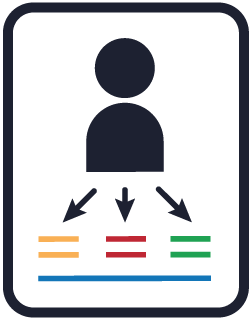Response
What Will You Learn?
In this lesson, we will explore how Acme initiates an emergency response. You will learn:
- Why the emergency management plan (EMP) uses the colour code system.
- The different colour codes and the incidents they represent.
- How to properly announce and terminate colour codes.

Colour Codes
What is the purpose of colour codes in emergency response?
Your EMP uses a standardized colour code system to quickly communicate different types of incidents and emergencies to staff members. Using colour codes like Code Black rather than incident descriptions such as “Bomb Threat” helps prevent panic among clients and visitors. This aids staff members in responding appropriately to the incident. Each colour code is accompanied by appendices, which include checklists, forms, and procedures, to aid in the response efforts.

“The response phase of emergency management involves taking immediate and coordinated actions to minimize the impact of an incident.”
All Colour Codes
Hover over each card to see the types of incidents the colour code applies to.
Code Black
Bomb Threat, Suspicious Package

Code Blue
Medical Emergency

Code Brown
Carbon Monoxide Detection, Natural Gas Leak, Chemical Threat, Liquid/Chemical Gas Spill

Code Green
Evacuation

Code Grey
Loss of Essential Services – Building Structural Failure, Elevator Malfunction, Mag Lock Failure, Loss of Utilities, Fire Detection Failure, Cybersecurity

Code Orange
Air Exclusion, Weather Watch, Weather Warning, Shelter for External Group

Code Red
Fire

Code White
Violence, Aggression, Active Attacker

Code Yellow
Missing Person

Announcing Colour Codes
How are colour codes announced?
When the Manager/Designate announces a colour code, it initiates specific actions to help manage the incident. The Announcing Colour Codes document details the format used for all colour code announcements. The announcement is repeated three times over the PA system or intercom to ensure everyone hears it. If these systems fail, a megaphone may be used, or staff members can be dispatched to notify others.

“Attention all staff members, Code ______; (Announce Location)”
“Attention all staff members, Code ______; (Announce Location)”
“Attention all staff members, Code ______; (Announce Location)”
Announcing a colour code.
After the initial code announcement is made, and only if appropriate, the Manager/Designate announces where the Incident Command Centre will be for the incident or emergency. This location may be identified either before the emergency as part of the planning process or during the emergency itself.

“Attention all staff members, Code ______; Report to ______”
“Attention all staff members, Code ______; Report to ______”
“Attention all staff members, Code ______; Report to ______”
Notifying staff members of the location of the Command Centre.
How are colour codes terminated?
Once the emergency response concludes, the Manager/Designate will announce three times that the colour code has ended, and staff members can resume normal operations.

“Attention all staff members, Code ______ has ended; All Clear”
“Attention all staff members, Code ______ has ended; All Clear”
“Attention all staff members, Code ______ has ended; All Clear”
Notifying staff members that the colour code has ended.
Responding to Colour Codes
To ensure a quick response, a Manager/Designate will announce the colour code and assign critical tasks to staff members to manage the situation. The most senior staff member present during an incident will assume the role of Incident Commander. The information below outlines the general actions that the Incident Commander (Manager/Designate) and staff members will take during colour code responses. Detailed instructions on how to respond to each colour code is provided in the nine colour code lessons within this course.

“Colour code announcements are standardized to quickly and clearly communicate the nature of the incident or emergency. This enables everyone to respond effectively and appropriately.”
-
Announcing a Colour Code
All Staff
- Ensure workstations are safe and secure before leaving.
- Follow emergency protocols as per specific staff member role(s).
- Respond to a code according to the protocol outlined in the EMP for the corresponding colour code.
- Ensure the safety of those onsite, such as clients, visitors, students, and volunteers.
Incident Commander
(Manager/Designate)- Announce the colour code three times over the PA system or intercom to ensure all parties hear it.
- Identify an Incident Command Centre, if one was not already chosen during the planning process.
- If appropriate, notify staff members of the location of the Incident Command Centre by announcing it three times.
- If there is a loss of power, use alternate methods of communication such as a bullhorn or runners.
-
Ending a Colour Code
All Staff Members
- Return to normal duties, unless otherwise directed by the Incident Commander (Manager/Designate).
Incident Commander
(Manager/Designate)- Determine if the emergency has ended and it’s safe to return to normal activities.
- Announce the termination of the code three times to inform staff members.
- Conduct a debrief session to review the incident (Hot Wash) as soon as practicable.
Did You Know?
Many organizations are enhancing their emergency response protocols to be more inclusive for staff members who are hearing impaired. Traditional audible alerts, like colour code announcements and alarms, may not be accessible to everyone. To address this, alternative systems are essential. By integrating multiple alert methods—such as digital signage, text alerts, and vibrating communication devices—organizations ensure that all staff members receive information simultaneously. This inclusive approach allows everyone to respond quickly and appropriately, improving both safety and efficiency during emergencies.

“The colour code system ensures everyone is aware of the type of emergency situation occurring. This information enables everyone to safely and efficiently coordinate their response.”
What Are Your Responsibilities?

- Ensure you read and understand Acme’s Response policies and colour code documents.
- Know what type of incident each colour code represents.
- Understand your role and responsibilities during all types of colour code responses.

 Check Your Understanding
Check Your Understanding
Refer to the lesson and EMP documents to answer all 3 questions. Review the feedback provided to reinforce your understanding of the content.


